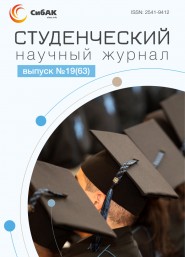Статья опубликована в рамках: Научного журнала «Студенческий» № 19(63)
Рубрика журнала: Информационные технологии
Скачать книгу(-и): скачать журнал часть 1, скачать журнал часть 2, скачать журнал часть 3, скачать журнал часть 4
CURRENT TENDENCIES OF COMMUNICATION DEVELOPMENT BETWEEN PEOPLE AND INFORMATION SYSTEMS IN PUBLIC PLACES
СОВРЕМЕННЫЕ ТЕНДЕНЦИИ РАЗВИТИЯ КОММУНИКАЦИИ МЕЖДУ ЧЕЛОВЕКОМ И ИНФОРМАЦИОННЫМИ СИСТЕМАМИ В ОБЩЕСТВЕННЫХ МЕСТАХ
Мезенцева Ольга Александровна
студент 2 курс, кафедра информационных технологий, МГСУ,
РФ, Москва
Просяновская Оксана Александровна
старший преподаватель, МГСУ,
РФ, Москва
Nowadays in most public places there are information systems that help to adjust the environment in order to make it as comfortable as possible. For example, lighting and climate control can easily been done automatically based on the data gathered by the sensors. Such systems have become common and widely used. What’s important is that people do not notice them in the building because they work invisibly and almost never require user’s impact. But with the world changing very fast, developers think of new ways of making everyday life easier and more comfortable. For example, why not make systems, which work inside the public buildings, help visitors and process their requests?
So, the new trend now is bringing the communication between people and information systems in public places. With a convenient interface, people can easily interact with the system.
For example, people constantly face a challenge of navigating in hypermarkets with thousands of items. It might take hours for people to get everything they need. As a result, they get tired and shopping turns into unpleasant necessity and people would want to come back much less. The indoor positioning system is meant to help with this. As it’s installed in the store, customers would only have to download a special app on their smartphone to connect to it. After they do so, the system provides creating order picking list and then automatically makes a route in the store according to the location of the products from the list. And as people walk down the aisles, they get personal offers and promotions on their smartphone screen.


Picture 1. The examples of app’s interface
What’s important is that no extra installations other than sensors are needed. These sensors are so small, that they can be installed, for example, in the luminaires.
This system works not only for customers, but also for owners. They can collect data about how customers are using space: their favorite choices and areas where they spend more time. Based on this information, retailers would optimize and improve layout in order to attract more customers. Also, the system keeps track on the number of the items in the store and helps workers to restock them on time.
All gathered information is stock in the cloud, so authorized owners can have access to it any time and place. Other workers can get only the information that is needed for their part of work. The system collects data only for analysis and further improvements, so no personal information about the customer (like ID or address) is required.
The way the system works is based on the same principle as GPS. The main difference is that it’s local and uses sensors instead of satellites. So, the positioning device, that is installed in the store, sends a unique code to the smartphone with the app. That’s how customers log in the system. The further data exchange is provided between the smartphone and the cloud server through radio channel which can be, for example, Bluetooth or WIFI.

Picture 2. The scheme of how the system works
Such systems are being developed for some time now and the first indoor positioning system is already working in a retail giant “Carrefour” in Lille, France. The patented Philips VLC (Visible Light Communication) technology is used to transmit a unique code through light that is undetectable to the human eye but can be simply detected with a smartphone camera, without the need for any additional accessories. In addition, the system will reduce energy consumption and increase sales. According to the reports, the feedback from owners and customers was mostly positive.
Such system can be used not only in stores, but also in other common areas like business centers, shopping malls, hotels - where navigating, locating and finding the right point can be a challenge for visitors.
What’s important is that no extra adjustments that would change the look of the area are needed. This means that the system might be as well used in the historical buildings without interfering with the atmosphere of the place.
Another feature that can be added to this system is used in the museums and galleries. The information about the exhibit will automatically appear on visitor’s smartphone screen as they approach it. This means that workers wouldn’t have to put tables or QR-codes near exhibits in the museum or gallery anymore. Very precise sensors locate the smartphone in the museum area to detect what exhibit people are interested in. The way this system works is similar to the indoor positioning system, the only difference would be in the software. The signal is also transmitted through radio or optical channel.

Picture 3. Application in the museums
To sum up, I’d like to say that I believe that the communication between people and information systems will get further development and also very soon will become a part of our everyday life making daily routine more pleasant and convenient. It will also save time and, in general, increase the quality of life.
References:
- http://www.lighting.philips.com/main/systems/lighting-systems/indoor-positioning
- https://www.erco.com/en/
- https://www.sylvania-lighting.com/en-int/smart-solutions/sylsmart/
- https://www.infsoft.com


Оставить комментарий